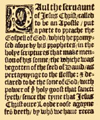|
 The first Bible to be written in the English language were translated to English by John Wycliffe, who wrote them by hand in the 1380s. Wycliffe, an Oxford theologian, used the fourth century Latin Vulgate as a basis for his translation, since the Greek and Hebrew languages of the Old and New Testaments were not accessible to him. Wycliffe devoted much of his life to writing and teaching against the practices and dogmas of the Roman Church, which he believed to be contrary to the holy writ. Although he died nonviolently, the Pope was so infuriated by his teachings that he ordered his body excavated, his bones crushed, and scattered in a river. The first Bible to be written in the English language were translated to English by John Wycliffe, who wrote them by hand in the 1380s. Wycliffe, an Oxford theologian, used the fourth century Latin Vulgate as a basis for his translation, since the Greek and Hebrew languages of the Old and New Testaments were not accessible to him. Wycliffe devoted much of his life to writing and teaching against the practices and dogmas of the Roman Church, which he believed to be contrary to the holy writ. Although he died nonviolently, the Pope was so infuriated by his teachings that he ordered his body excavated, his bones crushed, and scattered in a river.
Gutenburg invented the printing press in the 1450s. The first book to be printed was the Bible, which was printed in Latin. During the Reformation in the early 1500s, the Bible was illegally printed in English, and at great risk to those involved.
William Tyndale, an English reformer, worked to translate the Greek New Testament into plain English. His effort was made possible through Erasmus' publication of the Greek/Latin New Testament in 1516. Erasmus and printer/reformer John Froben published the first non-Latin Vulgate text of the Bible in a millennium. Latin, widely used amongst the literate, was considered the language of scholarship for centuries. Erasmus' Latin was not the Vulgate translation of Jerome, but his own rendering of the Greek New Testament text. Erasmus' translation revealed huge discrepancies in the Vulgate's integrity, convincing rank and file scholars, many of whom were already disenchanted with the established church.
Martin Luther nailed his 95 Theses of Contention to the Wittenberg Door. Luther, who would be exiled in the months after the Diet of Worms Council in 1521, would translate the New Testament into German from Erasmus' Greek/Latin New Testament, publishing it in 1522. William Tyndale would translate the New Testament into English, but he was not permitted to do this in England.
Tyndale worked to completed his New Testament in English. inquisitors and bounty hunters were on Tyndale's trail in an attempt to prevent the Bible from being translated into English. Nevertheless, in 1525 Tyndale printed the first translation of New Testament in English. The Bishop of London took steps to confiscate and burn them as they found their way into England, but copies continued to circulate among Christians, this despite the fact that possession of one of Tyndale's New Testaments carried a penalty of death by burning.
Betrayed by a friend, Tyndale was eventually taken into custody. Imprisoned for more than a year, he was strangled and burned at the stake in 1536. Only two copies of his first printing of the New Testament in English are known to have survived.
Myles Coverdale and John Rogers assisted Tyndale during the last six years of life, carrying the project forward after his death. Coverdale finished translating the Old Testament, and in 1535 he printed the first complete Bible in the English language, using Luther's German text and the Latin as sources. Thus, the first translation of the complete Bible was printed on October 4, 1535, and is known as the Coverdale Bible.
John Rogers later printed the second complete English Bible in 1537. He printed it under a pseudonym - Thomas Matthew - since a significant portion of his Bible was the translation of Tyndale, whose works were still condemned by the English authorities. It is a composite of the 1534-1535 edition of Tyndale's Pentateuch and New Testament, the Coverdale Bible, and Roger's own translation of the text. It is commonly known as the Matthew's Bible.
The climate changed. At the order of King Henry VIII, the Archbishop of Canterbury, Thomas Cranmer, hired Coverdale to publish the first English Bible authorized for public use. It was distributed to every church and chained to the pulpit. By the decree of the king, a reader was provided so that the illiterate could hear the Scriptures in their own language. Cranmer's Bible, published by Coverdale, was known as the Great Bible due to its large size - a large pulpit folio measuring over 14 inches tall. Seven editions were printed between 1539 and 1541.
|
